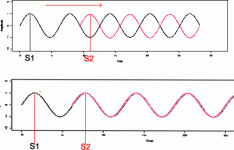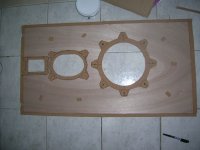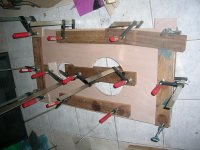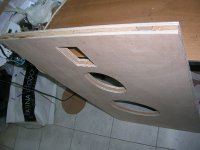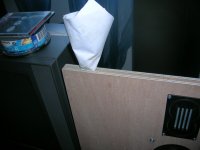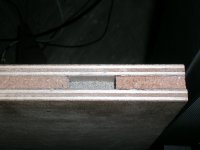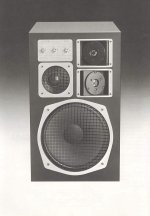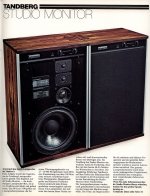Just for you*, dvv, see what can happen when two sources (S1 & S2) are seprarated in distance. The pressure wave propagate following the red arrow.
In the upper part of the image, pressure from the two sources will null each other (phase opposition) and sum in the other image with an other frequency.
The difference of distances between the listener and the speakers will depend of the angle he his from the axis.
You can reproduce the same effect in electronic, adding a delayed source with the original one. it will only be in 2D, while, in acoustic, you will create very complex 3D figures.
*And to demonstrate my fabulous expertise in front of the whole admiring world ;-)
In the upper part of the image, pressure from the two sources will null each other (phase opposition) and sum in the other image with an other frequency.
The difference of distances between the listener and the speakers will depend of the angle he his from the axis.
You can reproduce the same effect in electronic, adding a delayed source with the original one. it will only be in 2D, while, in acoustic, you will create very complex 3D figures.
*And to demonstrate my fabulous expertise in front of the whole admiring world ;-)
Attachments
Last edited:
Christophe, these are not sound wave breaking companies, they make "tame" domestic stuff. In case of Tandberg's 5025 and Monitor models, the two domes are placed one above the other, and in case of Saba, looking at the baffle at 0 degrees, one is turned to the left and the other above to the right by several degrees, I don't know how many, but I'd say at least by 25 degrees, probably more.
I suspect their reasoning was to obtain the extra +3 dB (I think?) SPL and to make them share the workload. In Saba's case, appearently to widen the dispertion angle as well.
I have no idea how they are internally connecetd, in series or in parallel.
I suspect their reasoning was to obtain the extra +3 dB (I think?) SPL and to make them share the workload. In Saba's case, appearently to widen the dispertion angle as well.
I have no idea how they are internally connecetd, in series or in parallel.
A question for all of you dedicated speaker people. I know what happens when I connect two transistors in parallel, and I've seen some speakers of old do the same with tweeters, products from Tandberg, Saba and a few others. What are the pros and cons of paralleling tweeters, of using two in place of one?
My guess would be to try to get wider horizontal dispersion and/or greater power handling for selected XO freq.
THx-RNMarsh
Bet for parallel, connecting speakers in serial is a very bad idea, unless you can perfectly pair them.I have no idea how they are internally connecetd, in series or in parallel.
This said, i wonder why, nowadays, the impedance of the commercial speakers tend to decrease, sometimes under 4 Ohms. During tube Jurassic era, the norm was 16 Ohms, while, for sloid state amps, 8 seems a good compromise. Remembering that a 8 Ohm boomer has often a 6 Ohms resistive moving coil.
Last edited:
Why should we want this, outside of P.A., exciting more room resonances and reflections ?My guess would be to try to get wider horizontal dispersion.
Last edited:
There are times when you will see a 2 or 3" dome tweeter like from Morel below a 1" dome tweeter and those usually are crossed over at different frequencies so they don't interfere with each other. Just because you tilt one dome tweeter and or move them to opposite corners of the enclosure does not mean they are not creating an interference pattern. Where is the common knowledge base here, how are we losing such simple understanding of what is going on here? It amazes me that we have some that can understand the smallest parasitic factors in an electronic circuit but the basics of acoustics are so little understood. No wonder there is so little real change or improvement happening with speakers. There are some real smart people on some of the speaker threads but again so much of the nonsense gets added to the discussion without understanding the very basics of what is going on.
Thanks Christophe,
I understand exactly what you are showing and I know there are others here who do also. If common knowledge and even graphic representations are just going to be ignored them why do we bother? Just because a name brand company does something doesn't make it right,
I know we should all just go out and buy some vintage Bose 901's, those 9 full rangers 4"ers had all the answers to dispersion and FR!
Thanks Christophe,
I understand exactly what you are showing and I know there are others here who do also. If common knowledge and even graphic representations are just going to be ignored them why do we bother? Just because a name brand company does something doesn't make it right,
I know we should all just go out and buy some vintage Bose 901's, those 9 full rangers 4"ers had all the answers to dispersion and FR!
Last edited:
Just to clear up minor points.
MDF is medium density fiber board. HDF is high density fiber board. Could be easily mistaken for Masonite. HDF is much not surprisingly heavier and a bit stonger than MDF. I have used it in 1.5" thick form to make among other things tooling jigs.
Agreed that most US made birch plywood is birch veneer over the usual fir ply wood. There is Chinese birch plywood made from Russian birch trees and it is solid birch but is much floppier than the same trees made by the Russians. When I get in Russian birch plywood the units are wrapped in 1 mm thick plywood with very distinct labeling in Russian. Now the Finnish Baltic birch is the best and most expensive. The main advantage is that the quality and dimensions are uniform. The Russian stuff can actually vary in thickness by a mm.
Finally wood is sold in units. The number of pieces varies with the size of the wood, the actual consideration is that a unit weighs less than 2 tons (2000 lB tons!) That way it can be handled by a forklift. So there are 132 1/4" pieces to a unit and 46 pieces of the " 3/4 inch" stuff. More if you get the 5' x 5' sizes we normally use around here.
My sliding table saw will handle 4' x 8' sheets nicely, but I don't like to lift them!
MDF is medium density fiber board. HDF is high density fiber board. Could be easily mistaken for Masonite. HDF is much not surprisingly heavier and a bit stonger than MDF. I have used it in 1.5" thick form to make among other things tooling jigs.
Agreed that most US made birch plywood is birch veneer over the usual fir ply wood. There is Chinese birch plywood made from Russian birch trees and it is solid birch but is much floppier than the same trees made by the Russians. When I get in Russian birch plywood the units are wrapped in 1 mm thick plywood with very distinct labeling in Russian. Now the Finnish Baltic birch is the best and most expensive. The main advantage is that the quality and dimensions are uniform. The Russian stuff can actually vary in thickness by a mm.
Finally wood is sold in units. The number of pieces varies with the size of the wood, the actual consideration is that a unit weighs less than 2 tons (2000 lB tons!) That way it can be handled by a forklift. So there are 132 1/4" pieces to a unit and 46 pieces of the " 3/4 inch" stuff. More if you get the 5' x 5' sizes we normally use around here.
My sliding table saw will handle 4' x 8' sheets nicely, but I don't like to lift them!
That was the meaning of "my fabulous expertise" joke.without understanding the very basics of what is going on.
FrankWW,
I personally have never seen any Masonite as thick as ostripper has mentioned unless someone glued together a bunch of sheets. Perhaps in another country that is available but I don't know where you would purchase 3/4" or 18mm thickness material. I wasn't about to ask ostripper to do a test and see if the material will peel apart, as the Masonite I've worked with will split into layers like a stack of paper. I would prefer either MDF or Baltic Birch myself. I just don't use what is called Birch ply made in America, it isn't really birch except for the outer layers and the rest is usually patched layers of Douglas fir and the gluing isn't that great. Unless you are going to use constrained layer construction MDF or Birch ply is the ticket.
OS's speaker box, the way he described the material, won't be masonite but either higher quality MDF or HDF, often called high density MDF, and it's lot's harder and denser than ordinary MDF.
Here's a manufacturer's description of the various kinds
Product Specifications | Plum Creek
Yes Christophe I got the joke. As I go back and forth from working on a design, the only reason I can keep up with the conversation is I need a break now and then from working on my cad drawings. I have been thinking of you as I struggle to design a diverging lens for a lighting application and how to integrate it into my design, I got boxed into a corner by competing design requirements and now I am having to learn new things about light diffraction and refraction to overcome something that should have been so simple. I think this same thing happens when designing speakers, some really bad industrial design decisions can put you in a corner and then you do strange things like divergent dome tweeters. I try to use the KISS principal but sometimes the wrong person is driving the bus and you have to figure out how to drive it from the back seat.
FrankWW,
Thanks I do understand and know the terms for the different woods and that is why I originally questioned the fact ostripper said Masonite. I used plenty of Masonite for bases of pattern for making tooling in aerospace, worked with and moved enough of that stuff that was why I asked the question. The difference between MDF and HDF board isn't that great, just more binder vs wood chip or wood dust used is about it. It isn't any fun moving full sheets of 1" mdf around the shop and getting it up on a table saw. One of the reasons that I have a vertical panel saw instead of a traditional table saw. Its a lot easier to move the saw down than push the full sheet through a fix blade table saw.
Thanks I do understand and know the terms for the different woods and that is why I originally questioned the fact ostripper said Masonite. I used plenty of Masonite for bases of pattern for making tooling in aerospace, worked with and moved enough of that stuff that was why I asked the question. The difference between MDF and HDF board isn't that great, just more binder vs wood chip or wood dust used is about it. It isn't any fun moving full sheets of 1" mdf around the shop and getting it up on a table saw. One of the reasons that I have a vertical panel saw instead of a traditional table saw. Its a lot easier to move the saw down than push the full sheet through a fix blade table saw.
Oh beware of not to wake Frank !...sometimes the wrong person is driving the bus and you have to figure out how to drive it from the back seat.
(hum, some kind of an Irony day ?)
Last edited:
In my enclosure, i used 2 boards glued together. One MDF, one of less density. and a foil of lead covered by Blakson paint inside. it is a big mistake. It is very mat, but so heavy: i had troubles at each of my relocation.
It is way better, on my opinion, to put many cleats between walls inside the enclosure, to dump the walls. Or, and, to think at creating a vacuum between the walls that we can garnish with dry sand...
That is the way i should consider my next horns: two walls in resin filled with sand ? Massive wood is perfect, and good looking, but sooo expensive !
For sand filled construction, the wooden panels have to be thin, otherwise you defeat the concept of sand absorbing panel vibrations.
8mm plywood with cork as spacer works very well. Pour in dry sand while vibrating the panels (a tedious job).
When you plan relocating, you can pour out the sand, so the panels (or boxes) can be lifted and moved easily.
If you mix resin with sand, there is no vibration absorption by sand (you immobilize and isolate sand grains). You only add mass to the resin.
George
Attachments
You can be patient and lie on the vibrations generated by the speakers themselves ;-) Just keeping some sand reserve apart and completing the fill-in from time to time.Pour in dry sand while vibrating the panels (a tedious job).
Nice pictures. I would have used different wood for the two panels for they have different vibration nodes.
Last edited:
.. a compilation of mistakes.These modles.
George,
A rented concrete vibrator or many other simple vibrators can be clamped to the panels and used to consolidate the sand, makes things easier but it is noisy.
Christophe,
I put him in my ignore list so I don't have to see the comments and get bothered by the continuous noise of speakers don't matter. I only have one other person in purgatory and I am glad not to see that persons comments either. That person was espousing that our speaker cabinets should vibrate like a musical instrument as the person who designed his speakers was a violin maker and said that was the answer to having speakers sound more realistic. Nobody could get him to understand all the bad things that come of a cabinet vibrating freely on all panels or even just the front panel. Time to go outside and unload a truck load of furniture and go get the last of it from the mother-in-laws garage. My poor back will remember it for a few more days.
A rented concrete vibrator or many other simple vibrators can be clamped to the panels and used to consolidate the sand, makes things easier but it is noisy.
Christophe,
I put him in my ignore list so I don't have to see the comments and get bothered by the continuous noise of speakers don't matter. I only have one other person in purgatory and I am glad not to see that persons comments either. That person was espousing that our speaker cabinets should vibrate like a musical instrument as the person who designed his speakers was a violin maker and said that was the answer to having speakers sound more realistic. Nobody could get him to understand all the bad things that come of a cabinet vibrating freely on all panels or even just the front panel. Time to go outside and unload a truck load of furniture and go get the last of it from the mother-in-laws garage. My poor back will remember it for a few more days.
Last edited:
HDF is much not surprisingly heavier
I used 0.7'' thick (unlaminated) high density fibreboard to make closets (6 total)
The back panels size 30'' width by 95'' high, weigh ~60 lbs each.
50% higher specific weight than MDF.
Moved them 3 times since manufacture, not the smartest thing I did.
A closet for life, even if it kills you.
George,
A rented concrete vibrator or many other simple vibrators can be clamped to the panels and used to consolidate the sand, makes things easier but it is noisy.
Christophe,
I put him in my ignore list so I don't have to see the comments and get bothered by the continuous noise of speakers don't matter. I only have one other person in purgatory and I am glad not to see that persons comments either. That person was exposing that our speaker cabinets should vibrate like a musical instrument as the person who designed his speakers was a violin maker and said that was the answer to having speakers sound more realistic. Nobody could get him to understand all the bad things that come of a cabinet vibrating freely on all panels or even just the front panel. Time to go outside and unload a truck load of furniture and go get the last of it from the mother-in-laws garage. My poor back will remember it for a few more days.
Actually, somewhere in the mid 90ies, Onkyo had that exact pitch for a small, wildly expensive speaker they were pushing, again comparing it to the violin body. If memory serves, they didn't make it.
- Status
- Not open for further replies.
- Home
- Member Areas
- The Lounge
- John Curl's Blowtorch preamplifier part II
